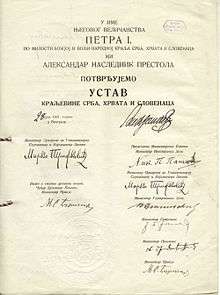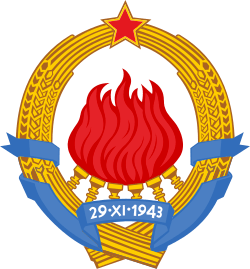Vidovdan Constitution
The Vidovdan Constitution was the first constitution of the Kingdom of Serbs, Croats and Slovenes. It was approved by the Constitutional Assembly on 28 June 1921 despite the opposition boycotting the vote. The Constitution is named after the feast of St. Vitus (Vidovdan), a Serbian Orthodox holiday. The Constitution required a simple majority to pass. Out of 419 representatives, 223 voted for, 35 voted against and 161 abstained.[1]
The Constitution was in effect until King Alexander proclaimed his 6 January Dictatorship on that date in 1929.
Vote

For
Against
- Yugoslav Social-Democratic Party
- Yugoslav Republican Party
- Foreign Minister Ante Trumbić
Boycotted
- Communist Party of Yugoslavia - left assembly in June
- Croatian Republican Peasant Party - boycotted assembly since 1920 elections
- Slovenian People's Party - left assembly in June
- Croatian People's Party - left assembly in June
- Croatian Union - left assembly in May
Alternative proposals
Croatian Republican Peasant Party
The Croatian Republican Peasant Party adopted its Constitution of the neutral peasant republic of Croatia in Zagreb on 1 April 1921.[2]
Croatian Union
The Croatian Union had proposed a confederation of the kingdom into six entities:[3]
- Serbia
- Croatia
- Montenegro
- Bosnia and Herzegovina
- Vojvodina
- Slovenia
Aftermath
On 30 June, an editorial in the People's Radical Party's journal Samouprava stated, "This year's Vidovdan restored an empire to us".[4] On 21 July, the Minister of the Interior and member of the People's Radical Party Milorad Drašković was assassinated in Delnice by a group of communists.[5]
The viability of the constitution dominated the 1923 parliamentary elections.[6]
The Croatian Peasant Party did not accept the legitimacy of the constitution. After the 1925 elections, entry into the government was offered to the party by Nikola Pašić. The Croatian Peasant Party accepted and recognized the constitution. Leader Stjepan Radić from prison, along with other party officials.[7]
References
- ↑ Robert J. Donia, John Van Antwerp Fine; Bosnia and Hercegovina: A Tradition Betrayed. Columbia University Press, 1995. (p. 126)
- ↑ Pod teretom nerešenog nacionalnog pitanja, Danas
- ↑ Anne Lane, Yugoslavia: When Ideals Collide.(New York Palgrave Macmillan; 2004). (p. 54)
- ↑ Banac 1988, p. 404.
- ↑ Ramet 1988, p. 58.
- ↑ Joseph Rothschild, Peter F. Sugar, Donald Warren Treadgold; East Central Europe Between the Two World Wars. University of Washington Press, 1979. (p.218)
- ↑ R. J. Crampton, Eastern Europe in the twentieth century. Routledge, 1994. (p. 137)
